BOOK OF HOURS, of unrecorded use, in Latin and French, ILLUMINATED MANUSCRIPT ON VELLUM , [northeastern France, c.1470s].
BOOK OF HOURS, of unrecorded use, in Latin and French, ILLUMINATED MANUSCRIPT ON VELLUM , [northeastern France, c.1470s]. 165 x 122mm. 150 leaves, written space: 85 x 63mm, rubrics in red, initials in red or blue and illuminated initials on red and blue grounds throughout, EIGHT LARGE MINIATURES , seven of which within full borders (lacking three miniatures before ff.15, 66 and 69, occasional loss of pigment to miniatures, e.g. to face of Virgin on f.27v, some staining to final leaves). 17th-century beige deerskin (scuffed and lightly frayed at spine). PROVENANCE: (1) The present Book of Hours is unusual in several respects. The use is closest to that of Angers or Saint Julien de Tours, but is not a precise match. Elements in the style of illumination point to a Parisian, or north-eastern French localisation and St Firmin, the patron saint of Amiens, appears in red three times in the calendar. (2) The prayer to St Christopher uses feminine forms, the uncommon prayers to the Holy Wound and to the Holy Mouth contain specific references to pregnancy and labour and particular emphasis is placed on the devotion to St Anne, patron saint of pregnant women: all perhaps clues to the identity and condition of the original owner. (3) WILLIAM OUSELEY (1767-1842) , British orientalist, artist and linguist: his inscription on inside upper cover, Paris, 1788. (4) ‘A. Fernar’: inscription inside upper cover (partially covered). (5) GEORGE DUNN (1864-1912) , of Woolley Hall near Maidenhead: his bookplate inside upper cover, his notes and initials with the date March 1904. (6) RICHARD DE LOMÉNIE : 20th-century bookplate with his arms, crest, name, motto ‘Je maintiendray’, beside a circular label ink-stamped '15' (see a Book of Hours for the use of Langres sold at Christie’s 7 July 2010, lot 36), along with an inserted note likely in his hand, bought November 1941. CONTENT: Calendar ff.1-12v; Gospel extract f.13-14; Hours of the Virgin, with Hours of the Cross and of the Holy Spirit intermixed ff.16-74v (the prayer to the holy wound, in French, f.42-43); Seven Penitential Psalms and Litany ff.75-94v; prayers to the Virgin, St Christopher, Barbara and Anne ff.95-104v (including the French rubric ‘Quiconques dira ceste oroison en lhonneur de madame sainte anne par devotion il aquerra pour chascun jour viii mil ans et mil quarantaines de vray pardon’); prayers in French: to the Virgin, in verse, ff. 105-110v, to the Holy Mouth ff.110v-114v, 15 Joys of the Virgin ff.115-121v, Seven Requests ff.122-127, another prayer to the Virgin ff.127-128v; Office of the Dead (3 lessons) ff.129v-150v. ILLUMINATION: AN ICONOGRAPHICALLY STRIKING FRENCH BOOK OF HOURS, HIGHLY PERSONALISED FOR ITS POSSIBLY PREGNANT OWNER . The framing of the miniatures finds echoes in the Parisian school of illumination, while the landscapes and the figures draw us further east and contain elements of southern Netherlandish art. The iconography of the miniature depicting the Holy Wound is particularly striking: uncommon in manuscripts, we find it more often in printed horae of the later 15th and 16th centuries (see I. Delaunay, Echanges artistiques entre livres d'heures manuscrits et imprimés produits a Paris vers 1480-1500 , Paris, 2000, plates XXVIII and XXIX). An angel, kneeling before the cross, supports an oversized blood-filled golden chalice, its shape an exact representation of the spear-wound inflicted on Christ on the cross. A near-identical composition can be found in a late 15th-century printed horae by Caillaut and Martineau (see E. Mâle, L’art religieux à la fin du Moyen Age , 1908, pp. 107-109 and fig. 56). The prayer to the Holy Wound that accompanies it is also more frequently found in printed horae , but only in a handful of manuscripts (including the Hours of Antoine Bourdin, Carpentras, BM, 59; Vienne, Bibl. nat. 2003, and Toulouse, Ancien 5861). The manuscript also contains the equally unusual prayer to the Holy Mouth, in French verse (J. Sonet, Répertoire
BOOK OF HOURS, of unrecorded use, in Latin and French, ILLUMINATED MANUSCRIPT ON VELLUM , [northeastern France, c.1470s].
BOOK OF HOURS, of unrecorded use, in Latin and French, ILLUMINATED MANUSCRIPT ON VELLUM , [northeastern France, c.1470s]. 165 x 122mm. 150 leaves, written space: 85 x 63mm, rubrics in red, initials in red or blue and illuminated initials on red and blue grounds throughout, EIGHT LARGE MINIATURES , seven of which within full borders (lacking three miniatures before ff.15, 66 and 69, occasional loss of pigment to miniatures, e.g. to face of Virgin on f.27v, some staining to final leaves). 17th-century beige deerskin (scuffed and lightly frayed at spine). PROVENANCE: (1) The present Book of Hours is unusual in several respects. The use is closest to that of Angers or Saint Julien de Tours, but is not a precise match. Elements in the style of illumination point to a Parisian, or north-eastern French localisation and St Firmin, the patron saint of Amiens, appears in red three times in the calendar. (2) The prayer to St Christopher uses feminine forms, the uncommon prayers to the Holy Wound and to the Holy Mouth contain specific references to pregnancy and labour and particular emphasis is placed on the devotion to St Anne, patron saint of pregnant women: all perhaps clues to the identity and condition of the original owner. (3) WILLIAM OUSELEY (1767-1842) , British orientalist, artist and linguist: his inscription on inside upper cover, Paris, 1788. (4) ‘A. Fernar’: inscription inside upper cover (partially covered). (5) GEORGE DUNN (1864-1912) , of Woolley Hall near Maidenhead: his bookplate inside upper cover, his notes and initials with the date March 1904. (6) RICHARD DE LOMÉNIE : 20th-century bookplate with his arms, crest, name, motto ‘Je maintiendray’, beside a circular label ink-stamped '15' (see a Book of Hours for the use of Langres sold at Christie’s 7 July 2010, lot 36), along with an inserted note likely in his hand, bought November 1941. CONTENT: Calendar ff.1-12v; Gospel extract f.13-14; Hours of the Virgin, with Hours of the Cross and of the Holy Spirit intermixed ff.16-74v (the prayer to the holy wound, in French, f.42-43); Seven Penitential Psalms and Litany ff.75-94v; prayers to the Virgin, St Christopher, Barbara and Anne ff.95-104v (including the French rubric ‘Quiconques dira ceste oroison en lhonneur de madame sainte anne par devotion il aquerra pour chascun jour viii mil ans et mil quarantaines de vray pardon’); prayers in French: to the Virgin, in verse, ff. 105-110v, to the Holy Mouth ff.110v-114v, 15 Joys of the Virgin ff.115-121v, Seven Requests ff.122-127, another prayer to the Virgin ff.127-128v; Office of the Dead (3 lessons) ff.129v-150v. ILLUMINATION: AN ICONOGRAPHICALLY STRIKING FRENCH BOOK OF HOURS, HIGHLY PERSONALISED FOR ITS POSSIBLY PREGNANT OWNER . The framing of the miniatures finds echoes in the Parisian school of illumination, while the landscapes and the figures draw us further east and contain elements of southern Netherlandish art. The iconography of the miniature depicting the Holy Wound is particularly striking: uncommon in manuscripts, we find it more often in printed horae of the later 15th and 16th centuries (see I. Delaunay, Echanges artistiques entre livres d'heures manuscrits et imprimés produits a Paris vers 1480-1500 , Paris, 2000, plates XXVIII and XXIX). An angel, kneeling before the cross, supports an oversized blood-filled golden chalice, its shape an exact representation of the spear-wound inflicted on Christ on the cross. A near-identical composition can be found in a late 15th-century printed horae by Caillaut and Martineau (see E. Mâle, L’art religieux à la fin du Moyen Age , 1908, pp. 107-109 and fig. 56). The prayer to the Holy Wound that accompanies it is also more frequently found in printed horae , but only in a handful of manuscripts (including the Hours of Antoine Bourdin, Carpentras, BM, 59; Vienne, Bibl. nat. 2003, and Toulouse, Ancien 5861). The manuscript also contains the equally unusual prayer to the Holy Mouth, in French verse (J. Sonet, Répertoire
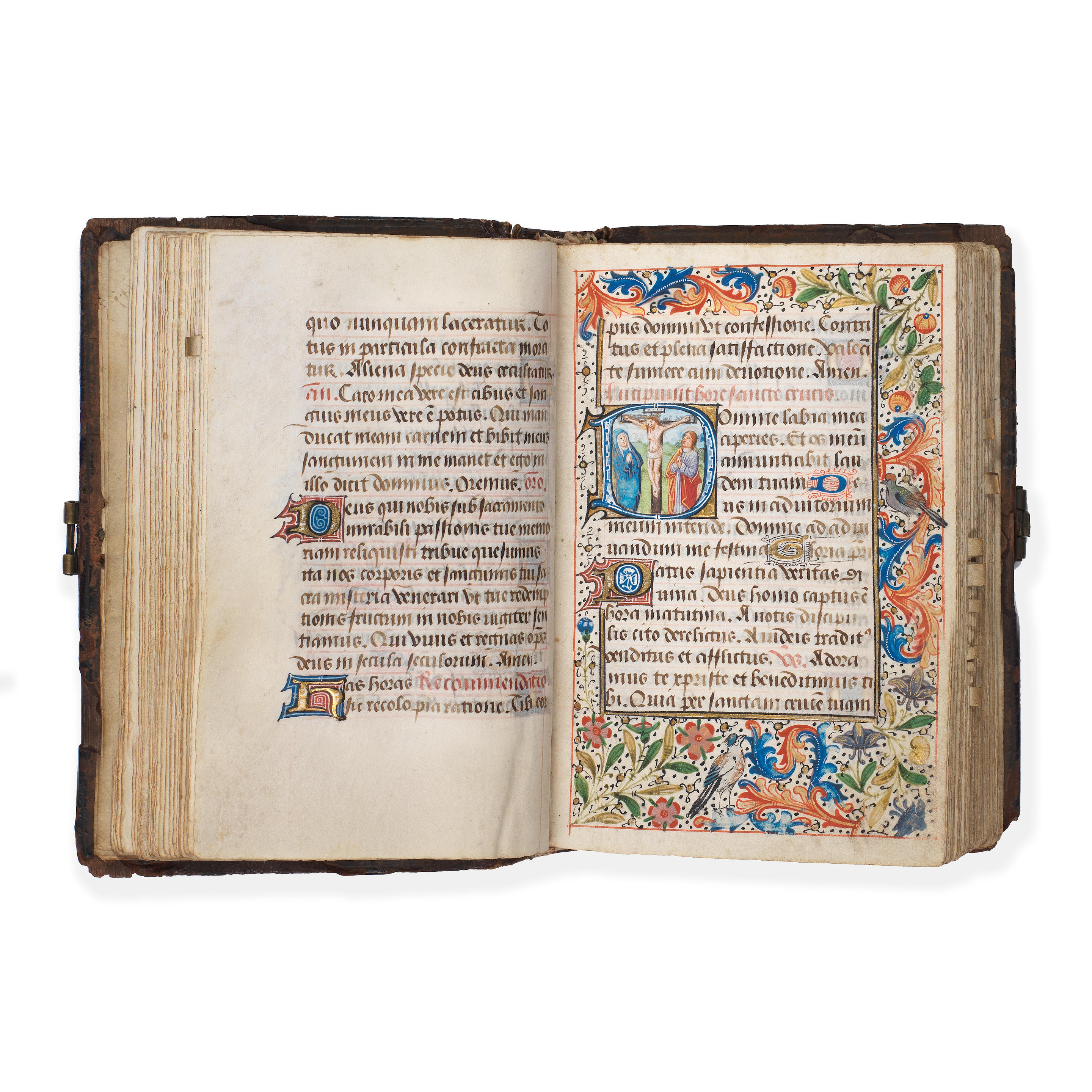
.jpg)

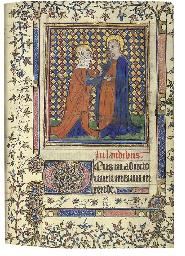
.jpg)

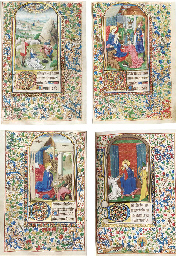


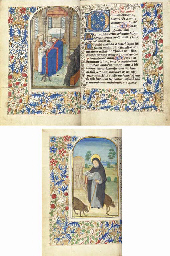
.jpg)


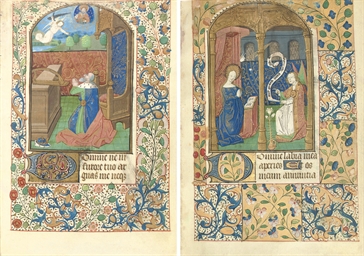

Try LotSearch and its premium features for 7 days - without any costs!
Be notified automatically about new items in upcoming auctions.
Create an alert